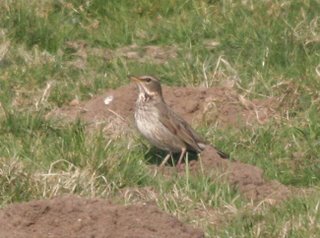
OK, so no posts for over a year, BUT I am back !
The changes since last year being - Wednesday are now a good team, I have a Canon 20D and 300 f4 lens, Buckton has at last had a BBRC rare !
Black-throated Thrush Turdus ruficollis atrogularis
Buckton, East Yorkshire March 25-27th 2007
As reported on here, Dave Wardby and myself are part of a small band of non-conformists who regularly waste their spare time scouring a bit of random cliff top at Buckton in East Yorkshire. Since proper coverage in 2001, much has been quietly predicted and anticipated but our delivery has been a bit slow. Our motto - roll on the ‘one in ten year’ bird!
After the dizzy heights of a Little Egret, a Barred Warbler, 15 Dotterel and a Yellow-browed Warbler in autumn 2006, the school report read ‘must try harder’!
Research of past records can provide a good insight to what may happen in the future and with this in mind during the winter doldrums we actively set about scrutinising the RSPB reserve reports from nearby Bempton Cliffs, as these hold some historical references to Buckton. One particular line of text made a real impression with me! The mortal words penned by then warden Steve Rooke in 1978 “the planting of any trees at Bempton will increase migrant potential” – was it as simple as that?. Little would Steve realise but these words led to Yorkshire first twitchable Black-throated Thrush, some 29 years later!
To be fare, we don’t cover Buckton that much in the winter but this winter we have purchased and acquired a mass of trees including willows, elders and hawthorns. On various dates since January, planting of the ‘magic wood’ has taken shape with over 300 saplings now in place.
On the morning of Sunday March 25th 2007, Jenny Atkins, Dave Wardby and myself added the finishing touches to the planting and at around 1600hrs we returned to our cars parked at Buckton village pond. Apart from a quick look at a migrant Long-eared Owl we had barely used our binoculars all day.
A quick scan of the pond revealed very little. I then walked a short distance to view a small undulating horse pasture just adjacent to the pond to the north. I noticed a small group of Blackbirds were feeding on the edge of the pasture and it became apparent that an increasing number of Blackbirds were emerging from an area of nearby gorse to feed in the open in the evening sunshine. Dave soon joined me and we counted 15 Blackbirds in total and surmised they were probably migrants.
I then saw a much greyer but similar sized thrush land amongst the blackbirds at some 160 metres distance. The bird had a very upright stance and was face on, showed a white throat, a streaked grey-washed breast and a white lower belly. I instantly suggested to Dave to get on to the bird, this he did and then moving from bins to scope resting on a fence post said “it looks like a Black-throated Thrush!” I replied “that’s just what I was thinking!”. Dave swiftly got his tripod from his car and we took turns to view the bird through his x60 zoom scope for the next few minutes (I didn’t have space to bring my scope due to the trees!). On a couple of occasions, in line with the accompanying Blackbirds, the bird retreated into the gorse patch but returned after a short period.
Besides its overall colouration and structure, the bird had a suite of technical features such as
- a broad white sub-moustachial stripe extending from the bill base to around the rear ear coverts where it became wider and more creamy-yellow coloured
- a prominent off white supercilium extending well beyond the eye,
- a dark malar stripe broadening at the base to form an almost ‘Short-toed Lark like’ patch but on the throat sides
- dark eye-stripe, lores and ear-coverts and a small thin white lower eye-crescent
- a prominent straw yellow bill with a dark tip extending along the upper mandible top edge
- dusky grey flanks contrasting with a whiter vent and darker almost black upper tail
- dark alula with pale carpal border and contrasting inner and outer greater coverts with three outer coverts tipped white
We made sure our identification was sound and came to the conclusion the bird was most probably a 1st winter/summer female and certainly of the race atrogularis (Dark-throated Thrush). One surprising feature was the prominence of the bird’s supercilia – a feature that we have subsequently found is not that well documented in literature and is certainly more associated to Dusky Thrush.
After a few minutes, I contacted several local birders both at Flamborough and Filey and the few local residents who live along Hoddy Cows Lane and informed them of unfolding events. News was then broadcast to Birdnet.
The thrush showed well on and off that evening and for the next two days, being last seen on the evening of Tuesday March 27th .It is great to report everybody was well behaved and parked sensibly, roll on the next ‘one in ten year bird’, hopefully in the magic wood!
Image courtesy of John Harwood
No comments:
Post a Comment